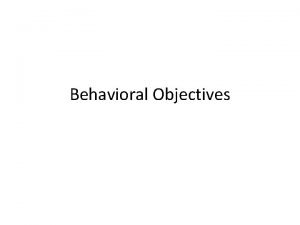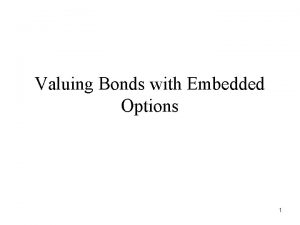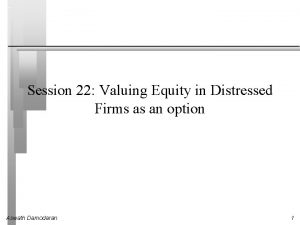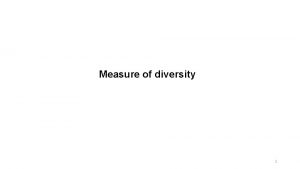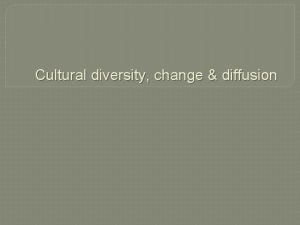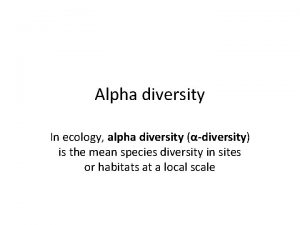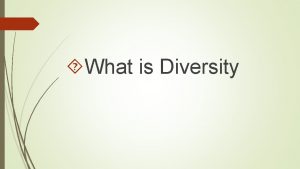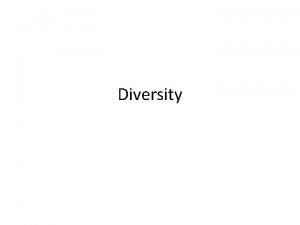Learning Goals What is valuing diversity Do valuing





















- Slides: 21

Learning Goals • What is valuing diversity • Do valuing diversity initiatives work? 1

Types of Diversity Initiatives • Managing Diversity • Change organizational structure, policies, norms & practices (e. g. , hiring) to create fairness • Similar to strategies reducing discrimination (Stephan & Stephan ch. 2) • Valuing Diversity • Change employee attitudes and behaviors by • Emphasis on equality/fairness values • Providing training on awareness & skills – Similar to strategies reducing stereotyping & prejudice (See Stephan & Stephan ch 2) 2

Valuing Diversity • Emphasize fairness/equality values • E. g. , mission statement, recruitment ads etc. • Provide diversity training to • Improve skills • E. g. , Interpersonal, conflict mgt, language skills etc. • Increase awareness/sensitivity • Cultural & historical information about groups • Know about stereotypes • Change attitudes & feelings • Hardest to do (e. g. , counteract stereotypes, reduce prejudice) 3

Purpose of one Diversity Training Exercise Online-discussion group for a course • Highlight differences in communication styles – Of people’s preference for communicating orally vs. online • Inter-cultural conflict resolution • Via discussing sensitive topics with a moderator • Increase cultural identity – Learn about each other’s culture • Reduce interpersonal stereotyping – E. g. , Bec. you are muscular you must be athletic • Reduce group stereotyping – E. g. , Bec. you are Chinese you must be conservative • Gain empathy – For people who are too shy to speak out in class 4

To improve skills or increase awareness…. . • Learn about culture • What is culture? • Beliefs, norms, customs, knowledge, habits of a group (e. g. , “What are transparent aspects of culture” cultural circles exercise) – Why learn about culture &/ cultural differences? • Increases awareness of role of culture in social interactions & behaviors (e. g. , choice of partner; amount of eye-contact) • Assumption: Awareness improves interactions with culturally different other 5

To change attitudes & feelings • Learn about stereotypes, prejudice etc. • What is a stereotype? • What is a prejudice? • How are they different from culture? 6

Does Diversity Training Work • Very few published/documented evaluations (<10) of diversity training efforts • One qualitative review of published evaluations of diversity training programs 8

Why such few Evaluations of Training Programs • • Trainers do not like sharing techniques Trainers do not know evaluation techniques Evaluation requires time and money Some evaluations take more time away from trainees’ jobs, are resisted by organizations • Showing no change (or negative change) is disadvantageous to trainer 9

Does Diversity Training Work • One qualitative review of published evaluations of diversity training programs 10

Evaluation of Diversity Training Programs • Tansik & Driskill 1977 • 20 hrs of lectures, case studies, role-playing • Small changes right after, positive changes 5 weeks after, negative attitudes 12 weeks after • Sorcher & Spence 1982 • 10 week prog of watching videotapes of effective behaviors, role playing with reinforcement • No changes immediately or 6 weeks after, but positive changes 20 weeks after 11

Evaluation of Diversity Training Programs • Dunnette & Motowildo (1982) • 3 -days of small group discussions, readings, seminars, videos on sexist attitudes & behaviors • No changes for men, but positive changes for women 12

Evaluation of Diversity Training Programs • Alderfer (1992) • Upward mobility program, balanced composition of promotion committees, workshop had lectures, roleplays and experiential activities • Increases in minorities in management ranks • Dominant group members evaluated program more negatively than minority group members 13

Evaluation of Diversity Training Programs • Ellis & Sonnenfield (1994) • 1 day of watching videos of culturally insensitive behaviors and discussing them • 59% evaluated seminar positively • Tan, Morris, & Romero (1996) • 3 days of case studies, simulations, videos, discussions • Increased knowledge of • Diversity issues • Barriers to change • Sensitization to and knowledge of how to prevent negative effects of prejudice & stereotypes 14

Evaluation of Diversity Training Programs • Hanover & Cellar 1998 • Videos, role playing, examination of diversity practices, action planning • Increased ratings on diversity practice measures (e. g. , open discussions of group differences, discouraging comments perpetuating stereotypes) • Rynes & Rosen 1995 • 33% of HR managers surveyed rated diversity programs as successful but 18% rated them as unsuccessful • Mandatory prog were rated as more successful 15

Evaluation of Diversity Training Programs • Layng 1998 • Analysis of commonly used video in diversity training programs • Introduced new stereotypes to replace old ones • Too much focus on incompetence of White male managers can alienate intended audience • Suggests that diversity leads to communication problems 16

Does Diversity Training Work • Conclusion from review of published evaluations of diversity training programs • They do not work 17

Why Diversity Training may fail • Content of Training • Participants • Changing established norms & practices of adults in organizations is difficult – Need managing diversity initiatives to occur simultaneously (e. g. , Alderfer, 92) • Mismanagement of expectations – Limited time for change to occur – Attitudes/feelings hard to change 18

Content of Diversity Training • Teach inter-group aspects – E. g. , Emphasize similarity & differences within groups as in cultural circles • Teach Legal aspects – E. g. , Discrimination scenarios exercise – Focus on training skills bec. employers are legally responsible for employee behaviors • Added benefit of making diversity policies palatable to all • Confrontation of Values • Prevalent organizational values • Value differences between groups 19

Participants of Diversity Training • Before Training: Composition of training group • Majority & minority members • Members from all organizational ranks, • Diverse trainers on teams 20

Participants of Diversity Training • During training, anticipate • Majority/dominant groups • Majority members may feel additionally threatened (e. g. , as being attacked during training) • Mandatory nature can be resented – People who need it the most get it but popularity may be reduced • Minorities • have negative reactions re: slow pace of change • may feel uncomfortable when focus of attention during training • Conflict between majority & minority groups 21

What we learned… • Valuing Diversity involves training for skills, increasing awareness, changing attitudes • Very few evaluations of diversity training programs – Review shows they do not work – Can be due to several challenges that confront diversity trainers 22
 Strategic goals tactical goals operational goals
Strategic goals tactical goals operational goals Strategic goals tactical goals operational goals
Strategic goals tactical goals operational goals What is ecosystem biodiversity
What is ecosystem biodiversity Ecosystem jigsaw activity
Ecosystem jigsaw activity General goals and specific goals
General goals and specific goals Examples of generic goals and product-specific goals
Examples of generic goals and product-specific goals Cuadro comparativo e-learning m-learning b-learning
Cuadro comparativo e-learning m-learning b-learning Valuing private companies
Valuing private companies Psychomotor domain objectives examples in lesson plan
Psychomotor domain objectives examples in lesson plan Psychomotor objectives examples
Psychomotor objectives examples Behavior domains
Behavior domains Pericles describes athenian society as valuing
Pericles describes athenian society as valuing Valuing oral language quotes
Valuing oral language quotes Valuing innovation
Valuing innovation Valuation of ip
Valuation of ip Valuing time in professional ethics
Valuing time in professional ethics Valuing callable bonds
Valuing callable bonds Bonds with embedded options
Bonds with embedded options Valuing distressed companies
Valuing distressed companies Valuing culture
Valuing culture Valuing land for social housing
Valuing land for social housing Valuing commodity companies
Valuing commodity companies









